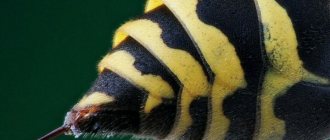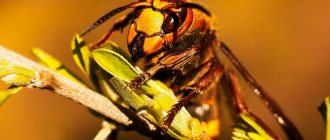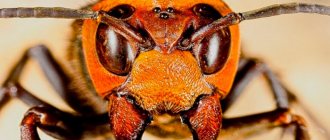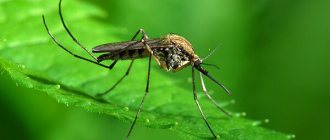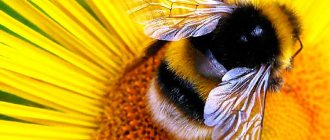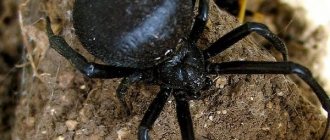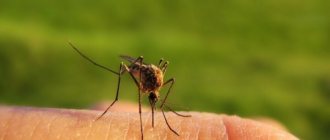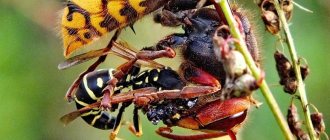A menacing buzzing makes many people anxious, and if something similar to a hornets’ nest appears in sight, there is a desire to get as far away from the dangerous place as possible. This is how people react to a potential threat. And this is correct, because the maximum risk of a bite occurs within a radius of 2–3 m from the nest.
Who is a hornet and why is it dangerous to humans? What to do if it bites and what could be the consequences? How to get rid of them and how do they differ from bees, wasps and bumblebees? Let's figure it out.
Who is the hornet
This is the largest representative of the so-called paper or social wasps. Their Latin name is Vespa, which literally translates as “wasp”. However, these are different insects that belong to the same family - true wasps.
Initially, no difference was made between the two representatives, and only in the 19th century the Vespa genus was divided into two groups. The description was based on several characteristics, but the main one was size - hornets are larger and can reach a length of up to 5.5 cm. Insects that are today considered wasps are designated in Latin as Vespula, that is, “small wasp.” Their size is 1.5–2 cm in length.
The hornet's threatening appearance is given by the bright coloring of its head - a combination of yellow, black, and orange.
The aggressive image is complemented by a striped belly, strong jaws and large eyes. However, these insects, unlike wasps, are non-aggressive. Human bites occur when a nest is disturbed or in self-defense.
Biological description
Hornets belong to the genus - social wasps. They live in families. A swarm can include up to several thousand individuals. Their life processes are clearly organized. Thus, within the “community” there are separate “castes” that perform specific functions.
The task of the hornet queen is to leave offspring. She is the leader of the colony. Females are born from fertilized eggs in August and September. Hornets reproduce by mating mature insects. After the females are fertilized, the males die.
The female stores sperm during the winter. With the onset of warm spring days, the queen begins to actively feed and regain strength in order to begin creating honeycombs for laying eggs. Thus, it forms the foundation of the future nest.
How long a hornet lives depends on its “profession”. Thus, males exist for one season, and the lifespan of the queen is a year.
The insect also has powerful jaws - mandibles. Literally speaking, hornets not only sting by injecting poison, but also bite. The insect uses mandibles to tear and grind prey.
During the active season, hornets feed on the juice of overripe fruits, trees, and honey. They hunt caterpillars, dragonflies, flies, spiders, related bees and wasps. They also cope with larger insects - crickets, locusts. There are descriptions of species capable of attacking birds and frogs. The prey is not used for food—the mass chewed and treated with saliva is used to feed the larvae.
Nests
The structure of a hornet's nest is based on hexagonal honeycombs.
The material is a substance similar to paper or cardboard. This is a lightweight structural element with thermal insulation properties of a brown color, which is obtained by mixing tree bark with insect saliva.
The place for the nest is chosen by the queen hornet. She does it where the offspring will be protected from excessive heat, cold and prying eyes.
Hornet nests reach 50–70 cm in length and are located in tree hollows, abandoned or used premises, cavities under roots, and piles of dead wood.
In the European Union, hornets are protected by law. For example, in Germany, the destruction of their nests is punishable by a large fine.
Area
Most species of hornets live in areas with a temperate climate, mainly in the northern hemisphere. Entomologists believe that they originally lived primarily in East Asia. There are several types of hornets on the territory of Eurasia, mainly the common and oriental ones.
People themselves play a major role in the spread of the insect. For example, a representative of the “common” species came to North America along with colonists from Europe in the middle of the 19th century.
In Russia, the hornet lives on a vast territory, which includes the European part of the Urals, Transbaikalia, the Amur region, and southern Sakhalin.
Kinds
Representatives of the extensive Vespa genus include more than 20 species.
- Affinis - small striped one.
- Analis - found in East Asia, measuring 25–28 mm.
- Basalis - basal.
- Bellicosa - warlike.
- Bicolor - two-color.
- Binghami - Binghama - active at night.
- Crabro - ordinary.
- Ducalis - commander's - one of the largest in Russia.
- Velutina is tropical, but also lives in Europe, as it was accidentally introduced there.
- Dybowskii - Dybovsky - almost monochromatic - black-brown.
- Fervida - ardent.
- Fumida - variable.
- Mandarinia is the largest in the world and also very poisonous.
- Multimaculata - multi-spotted.
- Orientalis - eastern.
- Philippinensis - Philippine.
- Luctuosa is tropical, found in the Philippines and is the most poisonous.
- Simillima - similar, very similar to the common hornet.
- Vivax - lives in Asia.
- Soror - black-tailed.
- Tropica - tropical.
Eight species of hornets live in Russia. The leader in occurrence is the “ordinary” (Vespa Crabro), which is distributed throughout almost the entire country, including the Moscow region. It is absent only in northern latitudes. The eastern hornet (Vespa Orientalis) lives in the Caucasus. In the south of the Far East, six species of Vespa are found - Simillima, Dybowskii, Ducalis, Mandarinia, Analis, Dinghami.
Role in nature
The benefits that hornets bring:
- destroy harmful insects that parasitize garden crops and wild plants - aphids, mites, psyllids;
- pollinate plants;
- They hunt locusts, flies, wasps, sick, “old” bees.
Natural enemies of hornets in nature limit their population within useful limits and destroy sick individuals. Among animals, these are ants, some species of birds (starlings, wagtails). Hornets are also susceptible to parasites - mites, nematodes, parasites and even microscopic fungi.
Interesting Facts
There are more than 20 species of hornets in the world, differing in color, behavioral characteristics, and size. The largest representative is the Asian one (Vespa Mandarinia), whose length exceeds 5 cm. In China, it is known as the “bee tiger”. Its venom contains a neurotoxin.
The hornet's queen releases pheromones that influence males. With their help, the “queen” organizes the activities of the entire swarm.
In the 18th century, the French naturalist, physicist and mathematician René Antoine Reaumur studied the material from which wasps build their nests. The result was a proposal to use wood in the production of paper, because until that moment, it was made from rags.
Symptoms after a hornet bite
Local symptoms:
- burning pain,
- edema,
- redness,
- sometimes bullous changes (blisters),
- possibility of local infection,
- regional lymphadenitis and lymphangitis
General toxic signs:
- nausea,
- vomit,
- weakness,
- dizziness
After being bitten in the area of a blood vessel or in the neck or head, loss of consciousness and convulsions
Allergic symptoms:
- rash and itching on the skin of the body
- swelling of the eyelids and soft tissues,
- hemorrhage in the conjunctiva,
- nausea,
- bronchospasm,
- swelling of the larynx,
- tightness in the chest,
- lack of air,
Why is a hornet dangerous for humans?
The following components of the poison pose a danger to humans:
- phospholipase A2 is an enzyme that activates the inflammatory response;
- acetylcholine is a neurotransmitter that ensures the transmission of impulses;
- histamine is a mediator of immediate allergic reactions;
- mastoparan is a toxin of protein origin.
As a result of the influence of a “bouquet” of biologically active substances on the tissues of the human body, a protective systemic inflammatory response develops.
A hornet sting can be fatal to humans if the victim experiences an allergic reaction. The following complications may also develop:
- skin rashes;
- bronchospasm - obstruction of the airways with difficulty exhaling;
- hallucinations;
- paroxysmal pain in various parts of the abdomen, nausea, vomiting;
- convulsive syndrome;
- depression of consciousness;
- a sharp decrease in blood pressure with further cessation of blood circulation.
Single hornet bites during pregnancy and lactation do not pose a danger to the fetus and infant, since the amount of poison is insignificant to penetrate the placental barrier or into the liver of a nursing mother.
How dangerous is a hornet bite for a child? Due to the small body weight, the concentration of poison for his body is very high, so the symptoms are more pronounced. And also due to the fact that children react actively and unpredictably to buzzing insects, the risk of multiple attacks increases, increasing the development of allergic reactions. In order not to risk the child’s life if bitten, you should immediately call an ambulance, without waiting for allergies to appear and anaphylactic shock to develop.
What is the characteristic of a hornet bite?
This insect never attacks a person unless there is a reason for it. You can easily be near the insect without making any provoking movements. The hornet can attack if a nest is identified and someone is trying to either penetrate it or destroy it. If you actively wave your arms in a place where such insects accumulate, this can also cause aggression.
Hornet bites can be identified by a number of signs:
- The bite site swells and swelling appears.
- The reaction to the bite quickly spreads to other areas, occupying an increasingly larger area.
- A sharp pain is felt at the point of penetration of the sting.
- Heart rate increases.
- There is a sharp fluctuation in blood pressure.
If a person is prone to allergies, then some other factors appear:
- Nausea and possibly vomiting appear.
- The limbs begin to cool.
- Loss of consciousness, either complete or partial, is possible.
- There may be a blue discoloration of the neck, eyelids, face or ears.
- Attacks of suffocation appear, as well as swelling of soft tissues.
- Red spots appear on the body and peeling of the skin occurs.
On a note! Each organism reacts differently to a hornet sting, although not every organism can cope with its poison without special help. This is especially true if it is not a single bite, and also if a person is prone to allergies. In this case, various negative reactions are possible, with breathing problems, swelling of the larynx, or even death.
Causes of a hornet sting
The main reason for a hornet bite is self-defense, and it always tries to get away from a person first and stings only if it is grabbed.
The insect uses its sting only for the purpose of protection or to neutralize a resisting victim. Entomologists explain that hornets will not consume poison without justified biological expediency. After all, this is a valuable weapon that is necessary during hunting.
Having detected a threat, hornets release alarm pheromones, which call on other individuals to attack. Therefore, everyone who is within a radius of 2–3 meters from a disturbed nest or a killed hornet will be bitten.
How to avoid a hornet sting
Hornets, like other representatives of the wasp family, never attack a person without a clear reason. However, any sudden movements or waving of arms are perceived as an attack. When near an insect, you need to behave as calmly as possible, freeze in place for a few minutes, do not panic, do not scream or run away, try to slowly move away from the attacker.
To protect yourself from the attacks of a poisonous parasite, you must adhere to certain measures:
- When going on a picnic, you should not use various perfumes or strongly aromatic cosmetics, as they attract insects. It is also not recommended to wear bright, colorful clothing, which serves as an excellent bait for hymenoptera;
- You should not kill a hornet in close proximity to its nest, as this may anger the entire family;
- It is strictly forbidden to disturb the nest of insects, knock on it, or rock it.
If you find a nest of hornets near your home, you need to seek professional help from special services that can safely and quickly eliminate the problem.
Bite symptoms
The hornet does not leave a sting when it bites, so it can sting several times. This feature distinguishes it from bees. A large number of bites can be fatal to humans. Especially if you are allergic to wasp venom.
Symptoms that develop from a hornet bite:
- sharp, severe pain;
- swelling, redness;
- itching, burning at the bite site;
- increase in body temperature to high numbers;
- possibly manifestations of allergic reactions, including anaphylactic shock.
Why is a hornet sting so painful?
Despite the fact that hornets have well-developed, powerful jaws, insects do not use them when attacking people. When saying that a hornet bites a person, it means that it sticks a smooth, needle-sharp sting into the skin. The sting is hollow, and at the moment of the bite, under the influence of the abdominal muscles, the insect fills it with poison, which enters the victim’s blood.
Contains toxic substance:
- acetylcholine is a neurotransmitter responsible for the transmission of neuromuscular impulses;
- histamine – provokes an immediate response of the immune system and, as a result, allergies;
- norepinephrine – accelerates the spread of toxin throughout the body;
- phospholipases - negatively affect the condition of the walls of blood vessels, which leads to swelling and inflammation.
The combination of these ingredients causes severe pain when bitten, intoxication of the body, and the development of an allergic reaction.
First aid
What to do if bitten by a hornet? It all depends on where and under what circumstances it happened. It is important to protect people from mass attacks. The biological instincts of insects are aimed at survival, which means protection from external invasions. If there is a nest within 2–3 m, you must immediately leave the danger area. When indoors, you should close the windows and make sure there are no insects.
If a hornet bite occurs, the algorithm for providing first aid at home should be as follows:
- examine the wound;
- if a sting remains, for example, after hitting an insect, then carefully remove it;
- do not try to squeeze out the poison;
- suck out the contents of the wound as quickly as possible;
- treat the bite site with an alcohol wipe or liquid;
- to relieve pain and swelling, apply “cold”;
- if there are indications, then take an antiallergic drug, for example, Suprastin or Tavegil.
When treating a hornet sting at home, it is important to continue to monitor the condition of the victim. If alarming symptoms appear, you should consult a doctor.
What to do if a hornet bites a child? The algorithm of actions for providing first aid is the same as for adults. Then you need to calm the baby down, distract him from the unpleasant incident and seek the advice of a medical specialist. Incorrect assessment of symptoms, potential complications, and self-medication can significantly worsen the child’s condition.
Actions when bitten
It is very important to know what to do if you are bitten by a hornet, since proper first aid will help not only alleviate the condition of the stung person, but also prevent negative consequences.
Removing the sting
First aid
First aid for a hornet bite is as follows:
- carefully examine the wound, finding a sting, if there is one, remove it with tweezers;
- rinse the wound with clean water;
- treat the bite site with a disinfectant (hydrogen peroxide, weak solution of potassium permanganate, vodka);
- apply a cold compress to the affected area;
- take an antihistamine;
- if the bite is in the arm or leg, you can make a tight bandage above the affected area to slow down the spread of poison throughout the body.
Having provided first aid to a person after a hornet sting, it is necessary to monitor his condition for the first time, since an allergic reaction can manifest itself gradually.
If you feel worse, call an ambulance immediately. This will also be useful in the case of multiple bites, as well as bites to the head and neck.
ethnoscience
Our ancestors knew well what to do to alleviate a person’s condition after a hornet bite. Folk recipes are still relevant today, especially when there is no first aid kit at hand. You can help someone who has been bitten by:
- lotions with lemon juice;
- compress of grated fresh potatoes or onions;
- aloe pulp or juice;
- gruel of chopped plantain and parsley.
Calendula tincture or chamomile decoction will help relieve pain and swelling.
Allergy medications
An attack by several hornets can be fatal to a person, and for some, even a single bite poses a threat to life. Taking antihistamines is advisable for everyone after being stung by a hornet. For allergy sufferers, this is a necessary and urgent measure.
The most popular means:
- Suprastin;
- Cetrin;
- Claritin;
- Erius.
To speed up the removal of the toxin, after a hornet has bitten a person, it is recommended to take a sorbent, for example, Enterosgel, Polysorb or activated carbon.
Treatment
In the International Classification of Diseases, Tenth Revision ICD-10, a hornet sting is designated by code W57 - stinging by non-venomous insects and arthropods.
There is no specific antidote for a hornet sting. Therefore, treatment includes the use of the following drugs:
- analgesic;
- antihistamine;
- antipyretic;
- decongestant.
If life-threatening complications develop, intensive therapy is carried out in the intensive care unit.
If a hornet bites you on the head, namely, in the area of the face or neck, swelling may develop that affects the airways. This condition threatens the life of the victim and requires treatment in a hospital. Airway obstruction is an indication for hospitalization in the intensive care unit. Intensive therapy includes the administration of glucocorticosteroids (hormones of the adrenal cortex), diuretics, and, if necessary, connection to a ventilator.
Types of hornets and their lifestyle
The hornet is the largest representative of the wasp family, the body length of which varies from 2 to 2.5 cm, with the length of the uterus being about 3.5 cm. Most often, hymenoptera can be found in gardens, in the country, in flower forest glades, outside the city. They can build their nests anywhere: under the roof of a house, in trees, in bushes and other areas that are well protected from the negative effects of climatic conditions.
Based on the appearance of this representative of the Hymenoptera, it is easy to identify it from a wasp. Compared to the wasp, it has a more rounded anterior part of the abdomen and a large crown of the head. It also differs in the color of its chest: the hornet’s chest is brown with a reddish tint, while its younger relatives’ chest is black.
There are several dozen species of insects that live in different parts of the planet: Japanese hornet, common hornet, oriental hornet, lamentable hornet, Asian hornet, Dybowski hornet. The greatest threat to humans is from tropical species, the bite of which can be fatal. Insects that live in the spaces of our state are more harmless, and after their bite, death can only occur due to severe allergies and failure to provide competent first aid.
Did you know? In Eastern countries, more than 70 individuals die each year from a hornet sting. This death rate is significantly higher than the death rate from wildlife attacks.
Consequences
- children;
- elderly and senile people;
- patients with a history of allergies, chronic diseases of the heart, blood vessels, and respiratory organs.
The severity of symptoms and the possibility of developing complications depends on the health status of the victim.
If there was no allergic reaction of the body, then the inflammation caused by the hornet sting goes away in a few days. This can be judged by the reduction in swelling, redness, and pain in the wound area.
The damaged area may itch for some time. How to relieve itching after a hornet bite? It is enough to apply cold. If this is one of the symptoms of an allergic reaction, then you should consult a doctor who will prescribe antihistamines.
Consequences of hornet stings
The consequences depend on the number, location of the bite and the individual reaction of the body. May be observed:
- Severe headaches, dizziness and nausea.
- Heavy sweating and increased body temperature.
- Difficulty breathing and shortness of breath.
- Chills and fever. Frequent heartbeat.
The hornet's venom affects the central nervous system, causing its excitation and then sudden inhibition. Children are more difficult to tolerate bites; their intoxication passes more quickly, accompanied by a deterioration in well-being. The consequences of an attack differ depending on where the poison enters; the most dangerous area is the head and neck. Also the places where large arteries and vessels pass.
How to get rid of hornets
Smells that repel them:
- soapy;
- essential oils contained in red hot pepper;
- aroma of mint, geranium, basil, wormwood;
- smoke.
If a hornet has flown into a room, it will explore the space in search of a way out until it finds one. Therefore, to get rid of it in a house or apartment, the best solution is to simply open the window wider and allow it to get out. If you try to catch it using a jar or vacuum cleaner, there is a chance of being bitten.
Remedies for hornets:
- insecticides - Get, "Medilis-Super", "Delta-Zone", aerosol from wasp nests Mosquitall;
- traps - Argus Garden, Swissinno Wasp Trap;
- smoke bombs - “Mukhoyar”, “Quiet Evening”, “FAS”, “City”;
- ultrasonic or acoustic insect repeller - EcoSniper LS-989, Sititek Flash, Grad Ultra 3D, Weitech WK-0180;
- insecticidal lamps - Well, Mo-El, Hilton.
What else are hornets afraid of? They are repelled by plants - basil, geranium, mint, lemon balm, wormwood, hanging red pepper pods. With their help, you can get rid of hornets in your garden, yard or attic of a private house. It is enough to plant or lay out dry plants near the nest and after a while the insects themselves will prefer to move to another place.
First aid for a hornet sting
We examine the wound; it happens that the sting partially or entirely remains in the wound. If available, remove using tweezers.
- Wash with running water and antibacterial or disinfectant soap; laundry soap with more than 70% fat is suitable.
- Take an antihistamine (Suprastin, Tavegil) and painkiller Paracetamol.
- Wipe with a cotton swab soaked in alcohol, hydrogen peroxide, and a light pink solution of potassium permanganate.
- If possible, squeeze out the poison with your fingers.
- Apply a cold compress or ice pack.
- Also, at home, you can use a ground aspirin tablet, mix it with water and apply the paste to the wound.
- Swelling and itching will help relieve the juice of lemon, dandelion, onion, plantain leaves, parsley, mash the leaves until the juice appears and apply to the wound.
- Fresh cut of onion, cucumber and potato.
- Mint toothpaste, menthol, mint mouth rinse, menthol, eucalyptus.
- Ensure rest and plenty of fluids.
You can wait out a mild allergy at home, but serious consequences such as nausea, vomiting, deterioration in breathing, and a feeling of suffocation require urgent medical intervention
.
Difference from bee, wasp, bumblebee
| Wasp | Bee | Bumblebee | Hornet | |
| Size(cm) | 2,0–3,5 | 2,1–3,9 | 1,3–2,8 | Up to 5.5 |
| The structure of the sting | smooth | has jagged edges | smooth | smooth |
| Painful bite | The pain from a hornet sting is comparable in intensity to the sting of a wasp, bee or bumblebee. | |||
The hornet can also be confused with other insects.
- The gadfly is distinguished by its smaller size and color, which is dominated by gray and black shades. It belongs to synanthropic flies. Only one species attacks humans: the human skin botfly, which lives in Central America.
- The difference between Scolia and Hornet is in size. Its length is about 3 cm in females and 4.5 cm in males. There is also a difference in color - Scolia is almost all black, with only two yellow spots.
- A drone is a male honey bee. The difference from the hornet is in size (no more than 1.5–1.8 cm), less bright color and lack of a sting.
Let's summarize. The hornet is a large, brightly colored insect from the genus of social wasps. It has jaws and a sting hidden at the tip of the abdomen. People are bitten most often due to the instinct of self-preservation. This is facilitated by the fact that nests are often created in close proximity to human habitation. The consequences of a hornet sting are dangerous due to the appearance of an allergic reaction, with possible death from anaphylactic shock. Especially if the insect stung several times or a child, an elderly or senile person was injured. In this case, you should definitely seek professional medical help. If there was no allergy, then the inflammation goes away within a few days.
How hornets attack
The hornet is most dangerous near its nest - while protecting it, the insect can attack even without visible provocation from humans. And if it occurs to someone to try to remove the nest, drown it in a bucket or smoke out the inhabitants, then an attack is guaranteed.
When attacking, this large wasp releases special aromatic substances into the air, which are a signal for other individuals. As a rule, after such a “call”, all the inhabitants of the nest are distracted from their affairs and begin to attack - not only the offender, but generally anyone who is nearby. It is precisely such situations that are the most dangerous and most often lead to serious bites and even death of a person.
In general, getting a hornet “out of control” and provoking it into aggression is not an easy task, and you need to try very hard to, so to speak, anger the insect.
Thus, a hornet, busy hunting or collecting building material for a nest, is very indifferent to humans.
If an insect feels that it is being pursued, the first thing it will do is try to hide; if you try to catch him, he will also choose to escape. The hornet will take a defensive position and defend itself only when it is in the hands of a person, under his foot or other part of the body.
Thus, the aggressiveness of the hornet is a very ambiguous phenomenon. Like every person, every individual insect is aggressive in its own individual degree: some are very calm and bite only when there is a pronounced danger, while others can be provoked into attack even by seemingly non-aggressive actions in a person’s opinion.
This is interesting
The length of the sting of the European hornet is 3 mm, and the huge Asian hornet has twice that length - more than 6 mm.
A characteristic and very interesting feature of these insects is that the smaller the individual, the more aggressive it is. Thus, small Japanese hornets sting people more often than others and in large numbers, while their huge “brothers” are incredibly peaceful.
It is also useful to read: Hornet stings and their danger to humans
The European hornets that inhabit our country are also very calm and attack much less frequently than wasps or even bees. In most cases, hornets attack beekeepers and summer residents who try to destroy their nests or install special traps for wasps and hornets in the immediate vicinity of insect homes.
Review
“The only negative memory from this summer is the attack of hornets on me and my husband. We have an area near the planting, and from there the hornets fly to the blackberries. Somehow before everything went without conflicts, but this time we were attacked by many hornets at once. This is terrible, of course. As soon as he strikes, his eyes darken from pain. I was bitten by four hornets, my husband – by nine. Okay, we managed to quickly run into the shower and turn on the water. It scared them away. My head immediately began to pound, my legs began to give way, my heart ached. The husband seemed to feel better, but his whole face was so smashed that he could not open his eyes. We sat like that for half a day in front of the shower. I can’t get up, Sasha can’t go. Then we finally reached the summer kitchen, stuffed ourselves with pills, and decided not to call an ambulance. My bumps from the bites went away in a week, for Sasha – in ten days.”
Veronica, Uman
In the video about a hornet attack on a person:
When do hornets attack people and how can it be dangerous?
First aid for a hornet sting
We examine the wound; it happens that the sting partially or entirely remains in the wound. If available, remove using tweezers.
- Wash with running water and antibacterial or disinfectant soap; laundry soap with more than 70% fat is suitable.
- Take an antihistamine (Suprastin, Tavegil) and painkiller Paracetamol.
- Wipe with a cotton swab soaked in alcohol, hydrogen peroxide, and a light pink solution of potassium permanganate.
- If possible, squeeze out the poison with your fingers.
- Apply a cold compress or ice pack.
- Also, at home, you can use a ground aspirin tablet, mix it with water and apply the paste to the wound.
- Swelling and itching will help relieve the juice of lemon, dandelion, onion, plantain leaves, parsley, mash the leaves until the juice appears and apply to the wound.
- Fresh cut of onion, cucumber and potato.
- Mint toothpaste, menthol, mint mouth rinse, menthol, eucalyptus.
- Ensure rest and plenty of fluids.
You can wait out a mild allergy at home, but serious consequences such as nausea, vomiting, deterioration in breathing, and a feeling of suffocation require urgent medical intervention
.
Consequences of hornet stings
The consequences depend on the number, location of the bite and the individual reaction of the body. May be observed:
- Severe headaches, dizziness and nausea.
- Heavy sweating and increased body temperature.
- Difficulty breathing and shortness of breath.
- Chills and fever. Frequent heartbeat.
The hornet's venom affects the central nervous system, causing its excitation and then sudden inhibition. Children are more difficult to tolerate bites; their intoxication passes more quickly, accompanied by a deterioration in well-being. The consequences of an attack differ depending on where the poison enters; the most dangerous area is the head and neck. Also the places where large arteries and vessels pass.
Bitten by a hornet - what to do at home
Correct action within the first few minutes can prevent a lot of inconvenience and even save the life of a person suffering from allergies to bee, wasp and hornet stings!
The most important thing is to act quickly and decisively.
First, it is necessary to determine whether the person who was stung by the hornet is allergic to the poison. If this is the case, you need to remain calm and eliminate the risk of repeated bites. Most often, people who are allergic to hornet stings carry medicine with them to treat acute anaphylactic shock.
If a hornet bites you in the mouth, neck or face, you need to react quickly and call an ambulance, as swelling can block the airways. This can lead to loss of consciousness or even suffocation. If a hornet stings your tongue, throat or mouth while waiting for an ambulance, you should give him a cold drink, suck on ice cubes and a teaspoon of salt solution.
After a hornet sting, severe pain and burning are felt. It is necessary to examine the site of the bite and check whether there are any sting residues there. When a hornet bites, there should not be a sting in the wound, but if you still see it, carefully remove it with tweezers or a needle.
Then you need to vigorously wipe the affected area with one of the following products::
- a clove of garlic, cut into two halves,
- half an onion
- Parsley, marigolds, mallow or plantain also help well.
- A piece of apple applied to the bite site gives an excellent effect
- if there is nothing, you can pour a little vinegar (preferably apple cider vinegar) onto the bite site.
How to relieve swelling and swelling after a bite
We offer two traditional compress recipes that help relieve swelling and swelling at the site of the bite.
- 1 glass of water 150-200 ml
- ½ cup vinegar (apple vinegar is fine)
- ½ teaspoon ammonia
- ½ teaspoon citric acid
- 1 glass of vinegar or brandy 150-200 milliliters
Soak a cotton cloth with one of these two mixtures and place it on the tumor. Change the compress 5-6 times a day until swelling and swelling decrease and the wound heals.
It happens that a hornet bites you while you are eating fruit (often the insect is inside a grape, peach, etc.) - this is a very dangerous bite, because swelling of the tongue and oral mucosa and breathing problems immediately occur.
What to do? Immediately eat 1-2 cloves of garlic and take 1 tablespoon of wine vinegar. And then run to the nearest hospital, especially if you are prone to developing severe allergic conditions.
Prevention - how to avoid a hornet bite
Hornets are not as curious as wasps and they are not interested in people. They only attack if provoked. But if this happens, and the hornet still arrives, you should remain calm and move away from it. Or just stay still and calmly wait until it flies away. It is good to refrain from sudden movements and under no circumstances attempt to move your hands. Since he may consider such behavior as an attempt on his life. The hornet's natural reaction is to defend itself by stinging. When a hornet enters a house, the best thing to do is open the window and let it fly out. Or try using something oblong with a wide surface (for example, newspaper). A glass lid may be suitable, under which you place a piece of cardboard and, thus, drive it out.
It should also be remembered that hornets are much more nervous and aggressive on hot days. Strong odors (such as perfume) and alcohol can also be irritants. Keep this in mind when you are at the front of the house or in the garden. Bright contrasting or dark clothing also attracts hornets.
Hornets are hymenopteran insects from the paper wasp family that live mainly in families. The body size of an adult is 3 cm or more.
Hornets are hymenopteran insects from the paper wasp family that live mainly in families. The body size of an adult is 3 cm or more. A collision between a person and a hornet can happen anywhere; often the habitat of these insects is wooden buildings of people, tree hollows, and bee hives. Hornets feed on plant nectar and small insects. For example, bees.
Symptoms of a hornet sting
The poison of this insect does not pose a great danger to people. By the way, hornets are quite aggressive and are the first to attack if a person approaches them. Unlike bees, this hymenoptera does not leave a sting in the victim’s skin at the time of its bite, and the toxin entering its bloodstream can cause a serious allergic reaction, including the development of Quincke’s edema. In addition, hornet venom can lead to changes in the condition of the victim’s body, such as increased blood glucose levels, increased breathing, and heart rhythm disturbances.
The sting of a hornet is very painful, since it is a rather large insect with an impressive sting. In the first minutes after the so-called bite occurs, at the site of its localization the skin begins to burn strongly, swells, becomes red, after 2-3 hours the victim may experience the main signs of intoxication: headache, dizziness, nausea, increased body temperature, chills, increased sweating.
These manifestations can be weak or strong. This depends on the age of the hornet victim, the presence of certain chronic diseases, and her predisposition to allergies. Very rapidly signs of intoxication of the body appear in young children. If a hornet or other similar insect stings a child under the age of 16, you should definitely contact a specialist. This should be done as quickly as possible.
A hornet sting is accompanied by a severe allergic reaction in the form of urticaria and its complication – Quincke's edema. The latter poses a danger to human life, since it is often accompanied by swelling of the larynx, which complicates the breathing process. The appearance of extensive red spots on the victim’s body, merging into one whole, is a sign of urticaria and also requires timely assistance from a doctor.
First aid for a hornet sting
Immediately after a collision between a person and an insect occurs, you should carefully examine the site of the bite, since part of the hornet’s sting may remain on it. The sting must be removed from the skin using tweezers. Then the bite site should be thoroughly washed with antibacterial soap and disinfected with an alcohol solution. Insect stings may contain pathogenic bacteria, contact with the skin will lead to a severe inflammatory process.
If a hornet stings a person for the first time, and he, therefore, does not know how his body will behave in such a situation, it is recommended to take an antihistamine. This will avoid the occurrence of an allergic reaction and subsequent complications.
In the event of a bite from insects such as hornets, wasps and bees, going to a medical facility is not necessary, provided that the victim feels well and does not have allergy symptoms. You should definitely seek qualified help if:
- the victim’s health deteriorates sharply;
- the bite site is very swollen and painful;
- the victim has already experienced a severe allergic reaction due to a hornet sting;
- the victim is a child under 16 years of age;
- There was a bite of not one, but several hornets at once.
When confronted with several insects at once, the level of toxin in a person’s blood increases significantly, so signs of intoxication may be more pronounced.
Consequences of a hornet sting
Stinging insect bites are usually harmless to humans. Their main complications may include: urticaria, Quincke's edema, cardiac dysfunction, even cardiac arrest. The manifestation of certain signs of a hornet bite, as well as the severity of its consequences, completely depends on the location of the bite itself. The most dangerous insect bites are those that strike the head area and the passage of large blood vessels. In such cases, their poison enters the bloodstream, spreads very quickly throughout the body and reaches the brain.
Persons prone to an allergic reaction should avoid collisions with stinging insects, since severe allergies in some cases can lead to death (due to cardiac arrest, laryngeal edema, etc.).
Hornets are the largest representatives of the paper wasp family. The family is called paper because they build their houses from paper, which they themselves produce from wood by chewing and treating with their saliva. The size of an adult varies from 3 mm to 5.5 mm. They make their nests in both residential and industrial premises, tree hollows and bee hives. They feed on insects of other species - flies, bees, caterpillars, but mainly on sweet substances - nectar and plant juice. Hornets' powerful jaws allow them to crush grasshoppers, wasps and locusts. The insect is completely ground into a nutritional substance and fed to the larvae. Hornets are aggressive insects and can attack for no apparent reason, so any proximity of people and animals to them is dangerous. Next, we will tell you what to do if you are bitten by a hornet.
Interesting fact:
Since ancient times, hornets have been used as weapons of “mass destruction.” Pots filled with insects were thrown with catapults at enemies. A swarm burst out of the broken pots, bringing death and chaos to the ranks of the enemies.
Is a hornet's bite fatal to humans?
Redness, itching and abscess are the most common symptoms of a bite.
In itself, a hornet sting is no more dangerous than a bee or wasp sting. But here, too, everything depends on the type of insect. The Asian hornet is considered more dangerous than, say, the common hornet. In general, symptoms go away over time. However, there are exceptions that can result in death in the following risk category:
- allergy sufferers who are susceptible to the chemical components of the poison;
- children, especially infants;
- numerous bites in the event of an insect attack (based on the amount of poison introduced into the body, bites from 500 hornets cause death);
- a fatal bite occurs when the sting enters a blood vessel on the head or another large organ, in which the poison quickly reaches the brain.

